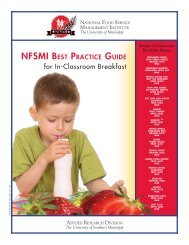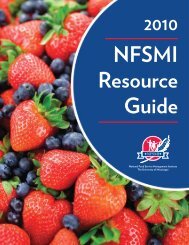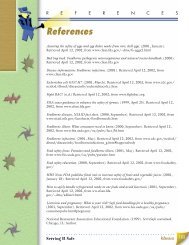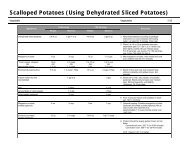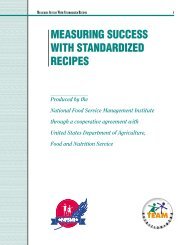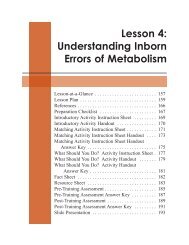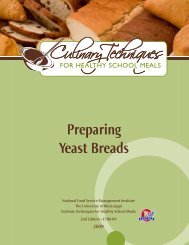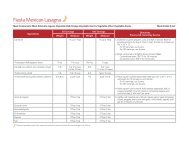financial management information system - National Food Service ...
financial management information system - National Food Service ...
financial management information system - National Food Service ...
You also want an ePaper? Increase the reach of your titles
YUMPU automatically turns print PDFs into web optimized ePapers that Google loves.
S ECTION 4FINANCIAL A NALYSIS AND P ROGRAM E VALUATIONAfter an evaluation of the productivity level is completed, the school foodservice administrator can make a decisionregarding staffing. If the evaluation indicates an overload and increasing participation is not an alternative, cuts in laborhours may be necessary. The following method can be used to determine the number of labor hours needed for the desiredproductivity level.1. Decide the desired number of MPLH for the school site. Assume ABC Elementary School set a goal of 17 MPLH basedon the type of meal service offered. An accepted industry guideline is 14 – 18 MPLH.2. Divide the total meal equivalents by the desired number of MPLH to determine the total labor hours needed per day.Example: 668 Total Meal Equivalents17 Desired MPLH= 39.3 Total Labor Hours3. Determine the number of excess labor hours daily that will need to be eliminated.Example: Current Paid Labor Hours 49.0Desired Paid Labor Hours -39.3Reduction needed 9.7 labor hoursN OTEThe number of paidlabor hours includesall labor charged toand paid for by theschool foodserviceoperation. Forexample, this mightinclude labor forcashiering, ticketselling, or custodialservices. If these laborhours were paid byschool foodservice,then they would beincluded in the totalnumber of paid laborhours whencalculating theproductivity index ofmeals per labor hour.The school foodservice administrator can make a decision to reduce the hours ofemployees or eliminate positions to increase MPLH.Volunteer laborThe number of meals per paid labor hour does not include volunteer labor. Ifvolunteer labor is used, then an additional measure of productivity must becalculated using total number of labor hours (both paid and unpaid). Thismeasure should not be compared to an operation using a productivity index tocalculate meals per labor because the comparison would not be valid. Theoperation using unpaid volunteer labor could have a higher number of meals perlabor hour than one using only paid labor.Average Daily ParticipationSchool foodservice administrators must have accurate <strong>information</strong> about theaverage number of students who will participate in the school lunch and breakfastprogram on a daily basis. The average daily participation is used to determinestaffing needs, purchase food and supplies, and schedule food production.Knowing the average participation over a period of time can assist schoolfoodservice administrators in making better <strong>financial</strong> <strong>management</strong> decisions thatstrengthen their programs’ resources.The average daily participation can be used as a forecasting tool to:• prevent waste in excess labor hours and overproduction of food, and• reduce customer dissatisfaction because of inadequate staff and too little foodprepared for the number served.N ATIONAL F OOD S ERVICE M ANAGEMENT I NSTITUTE 76




